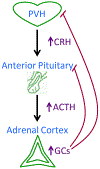HPA Axis Interactions with Behavioral Systems
- PMID: 27783863
- PMCID: PMC7219962
- DOI: 10.1002/cphy.c150042
HPA Axis Interactions with Behavioral Systems
Abstract
Perhaps the most salient behaviors that individuals engage in involve the avoidance of aversive experiences and the pursuit of pleasurable experiences. Engagement in these behaviors is regulated to a significant extent by an individual's hormonal milieu. For example, glucocorticoid hormones are produced by the hypothalamic-pituitary-adrenocortical (HPA) axis, and influence most aspects of behavior. In turn, many behaviors can influence HPA axis activity. These bidirectional interactions not only coordinate an individual's physiological and behavioral states to each other, but can also tune them to environmental conditions thereby optimizing survival. The present review details the influence of the HPA axis on many types of behavior, including appetitively-motivated behaviors (e.g., food intake and drug use), aversively-motivated behaviors (e.g., anxiety-related and depressive-like) and cognitive behaviors (e.g., learning and memory). Conversely, the manuscript also describes how engaging in various behaviors influences HPA axis activity. Our current understanding of the neuronal and/or hormonal mechanisms that underlie these interactions is also summarized. © 2016 American Physiological Society. Compr Physiol 6:1897-1934, 2016.
Copyright © 2016 John Wiley & Sons, Inc.
Figures



Similar articles
-
Influence of psychological variables on the activity of the hypothalamic-pituitary-adrenal axis.Eur J Pharmacol. 2000 Sep 29;405(1-3):149-60. doi: 10.1016/s0014-2999(00)00548-3. Eur J Pharmacol. 2000. PMID: 11033322 Review.
-
Social modulation of stress responses.Physiol Behav. 2003 Aug;79(3):399-407. doi: 10.1016/s0031-9384(03)00152-5. Physiol Behav. 2003. PMID: 12954434 Review.
-
Brain-derived neurotrophic factor and hypothalamic-pituitary-adrenal axis adaptation processes in a depressive-like state induced by chronic restraint stress.Mol Cell Neurosci. 2011 Jan;46(1):55-66. doi: 10.1016/j.mcn.2010.08.006. Epub 2010 Aug 11. Mol Cell Neurosci. 2011. PMID: 20708081
-
The role of the hypothalamus-pituitary-adrenal/interrenal axis in mediating predator-avoidance trade-offs.Gen Comp Endocrinol. 2016 May 1;230-231:110-42. doi: 10.1016/j.ygcen.2016.04.006. Epub 2016 Apr 11. Gen Comp Endocrinol. 2016. PMID: 27080550 Review.
-
Gonadal steroid hormone receptors and sex differences in the hypothalamo-pituitary-adrenal axis.Horm Behav. 1994 Dec;28(4):464-76. doi: 10.1006/hbeh.1994.1044. Horm Behav. 1994. PMID: 7729815 Review.
Cited by
-
Sex dimorphism in isoproterenol-induced cardiac damage associated neuroinflammation and behavior in old rats.Front Aging Neurosci. 2022 Jul 22;14:854811. doi: 10.3389/fnagi.2022.854811. eCollection 2022. Front Aging Neurosci. 2022. PMID: 35936761 Free PMC article.
-
Treating Hypopituitarism in the Over 65s: Review of Clinical Studies.Clin Interv Aging. 2023 Mar 21;18:423-439. doi: 10.2147/CIA.S370782. eCollection 2023. Clin Interv Aging. 2023. PMID: 36974195 Free PMC article. Review.
-
Glucocorticoid receptor action in metabolic and neuronal function.F1000Res. 2017 Jul 24;6:1208. doi: 10.12688/f1000research.11375.1. eCollection 2017. F1000Res. 2017. PMID: 28781762 Free PMC article. Review.
-
The mediation effects of nightmares and depression between insomnia and suicidal ideation in young adults.Sci Rep. 2024 Apr 26;14(1):9577. doi: 10.1038/s41598-024-58774-5. Sci Rep. 2024. PMID: 38670978 Free PMC article.
-
Corticosteroid-Induced Psychiatric Disorders: Mechanisms, Outcomes, and Clinical Implications.Diseases. 2024 Nov 23;12(12):300. doi: 10.3390/diseases12120300. Diseases. 2024. PMID: 39727630 Free PMC article. Review.
References
-
- Abe H, Hidaka N, Kawagoe C, Odagiri K, Watanabe Y, Ikeda T, Ishizuka Y, Hashiguchi H, Takeda R, Nishimori T, Ishida Y. Prenatal psychological stress causes higher emotionality, depression-like behavior, and elevated activity in the hypothalamo-pituitary-adrenal axis. Neurosci Res 59: 145–51, 2007. - PubMed
-
- Abercrombie HC, Speck NS, Monticelli RM. Endogenous cortisol elevations are related to memory facilitation only in individuals who are emotionally aroused. Psychoneuroendocrinology 31: 187–196, 2006. - PubMed
-
- Adam TC, Epel ES. Stress, eating and the reward system. Physiol Behav 91: 449–458, 2007. - PubMed
-
- Adamec RE, McKay D. Amygdala kindling, anxiety, and corticotrophin releasing factor (CRF). Physiol Behav 54: 423–431, 1993. - PubMed
-
- Adamec RE, Shallow T. Lasting effects on rodent anxiety of a single exposure to a cat. Physiol Behav 54: 101–109, 1993. - PubMed
Publication types
MeSH terms
Grants and funding
LinkOut - more resources
Full Text Sources
Other Literature Sources

